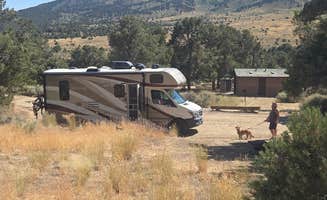Bob Scott Campground is currently closed for renovations with no set reopening date. Located in the Humboldt-Toiyabe National Forest near Austin, Nevada at 6,700 feet elevation, this area experiences significant temperature fluctuations with summer days reaching the 90s and nights dropping into the 40s. Winter brings snow and below-freezing temperatures, making most campgrounds in the region seasonal operations that close from November through mid-May.
What to do
Explore petroglyphs: At Hickison Petroglyph, visitors can examine ancient rock art along a short interpretive trail. "There is a sign marking turn. If going towards Austin it will be on the right side of highway. After you make the turn road becomes gravel and there is a cattle guard," notes reviewer N.I. The petroglyphs themselves are accessible via a walking path with interpretive signage.
Soak in hot springs: The mineral-rich waters at Spencer Hot Springs offer relaxation after hiking or driving. "The upper tub was not warm enough for me 97*. The lower however was 107* which I loved," reports TC A. The springs feature multiple soaking options including a constructed tub and more natural pools with varying temperatures.
Fishing opportunities: Anglers can fish for trout in Big Creek near Big Creek Campground. "There are trout in the creek and easily accessible depending on how much snow the mountain range got the winter before," explains graham K. Fish populations are seasonal and dependent on water levels, making spring and early summer typically the best fishing periods.
What campers like
Stargazing conditions: The remote location creates ideal dark sky viewing. "It was dark & desolate but somehow felt perfectly safe & we slept like logs. We woke just in time for the most spectacular sunrise & jack rabbits abound," writes PJ F. about their experience at Hickison Petroglyph. Limited light pollution allows visibility of the Milky Way on clear nights.
Wildlife encounters: The region hosts diverse desert wildlife including wild burros. "At sunset, kick back in your chair or in the hot spring and watch and listen to the wild burrows come in from the desert to drink and graze," shares Annie C. about Spencer Hot Springs. Morning and evening hours provide the best wildlife viewing opportunities.
Budget-friendly options: Free and low-cost sites make this area accessible for pet friendly camping near Austin. "This free site was better than most state parks! Drive in spots with picnic tables and fire pits, clean bathrooms, and cool petroglyphs," notes Kristian W. about Hickison Petroglyph. Most established campgrounds charge $5-10 per night with dispersed camping options available at no cost.
What you should know
Road conditions: Many camping areas require navigating unpaved roads. "Access to the campground is via a 2.5 mile long single lane dirt road. There are a few small wider spots to squeeze past oncoming traffic, but locals tend to travel fast, so be vigilant," warns Erik J. about Kingston Campground. High-clearance vehicles are recommended for accessing remote sites, especially after rain.
Limited amenities: Most campgrounds provide basic facilities or none at all. "No facilities but some rock fire rings. Please pack it in/pack it out!!" emphasizes Janet K. regarding Spencer Hot Springs. Campers should bring all necessary supplies including water, as most sites have no potable source.
Cell service variability: Connectivity ranges from none to surprisingly good. "Verizon is 3-4 bars!" reports TC A. about Spencer Hot Springs. Coverage is generally better at higher elevations and locations closer to Highway 50, with valleys often having no service.
Tips for camping with families
Beginner-friendly campground: Toquima Cave Campground offers accessible facilities for families. "Getting here was super easy. Don't need high clearance vehicle. Lots of trees, two or more pit toilets. Great rocks structures and lots of fire pits," shares Linda L. The campground's manageable access road makes it suitable for family vehicles without specialized equipment.
Safety considerations: Remote locations require extra preparation with children. "We love going out here. Gets busy on holiday weekends but decent during the week. Tons of trails to explore on dirt bikes and quads. A lot of horse trails," notes Matt D. about Big Creek Campground. Families should bring comprehensive first aid kits and emergency supplies due to distance from medical facilities.
Educational opportunities: Several sites feature natural or historical learning experiences. "Be sure to walk to the top of the ridge at sunset for some incredible views," suggests Kristian W. about Hickison Petroglyph. The interpretive trails provide opportunities to teach children about native cultures and geology in an outdoor classroom setting.
Tips from RVers
Site selection challenges: Many campgrounds have limited space for larger rigs. "We towed our 30 foot bumper pull behind our full size truck (49 feet tip to tail) and made it but this is right at the limits for maneuvering," explains Erik J. about Kingston Campground. Sites at most campgrounds accommodate smaller trailers up to 25 feet, with few options for larger RVs.
Unlevel terrain: Be prepared to level your RV at most area campgrounds. "Sites a bit unlevel but doable with 30 ft travel trailer. Slight trench from previous campers made it perfectly level," notes Cliff about Bob Scott Campground. Bringing additional leveling blocks is recommended as most sites have natural slopes.
Hookup availability: Full hookups are limited to in-town locations. "Tight parking spaces. Full hook up. Toilet and shower old but clean. One night 35 $," reports Holger E. about Austin RV Park. Most forest and BLM campgrounds offer no hookups, requiring RVers to be self-sufficient with water tanks and power.




